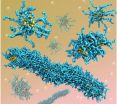(Press-News.org) Researchers from North Carolina State University have developed a novel and versatile modeling strategy to simulate polyelectrolyte systems. The model has applications for creating new materials as well as for studying polyelectrolytes, including DNA and RNA.
"Our new technique allows us to model much larger and more complex polyelectrolyte systems, and to do so much more quickly," says Nan Li, lead author of a paper on the work and a Ph.D. student in NC State's Department of Materials Science and Engineering. "This is a big step forward for this field."
Polyelectrolytes are chains of molecules that are positively or negatively charged when placed in water. Because they are sensitive to changes in their environment, polyelectrolytes hold promise for use in applications such as drug delivery mechanisms. The term polyelectrolyte system refers to any collection of molecules that interacts in some way and includes polyelectrolytes.
Researchers are interested in computation models that simulate the behavior of polyelectrolyte systems because these models can be used to determine which polyelectrolytes are most likely to have desirable characteristics for use in various applications. The models can also be used to help researchers understand the behavior of polyelectrolyte systems such as DNA, RNA or synthetic ionic polymers.
Polyelectrolyte systems are difficult to model, because the systems can be large and include a lot of ions that can interact with the polyelectrolytes, changing the actual charge, shape, properties and behaviors of the polyelectrolytes. The change in charge affects how the polyelectrolytes interact with each other. The more ions there are in the system, the more likely it is that the polyelectrolytes will be drawn to each other. This interaction of polyelectrolytes changes the behavior and characteristics of the overall system.
"The problem is that tracking all of the ion-polyelectrolyte interactions takes a lot of computing power," Li says. "We've developed a more efficient technique to account for the effect of the ions, and that allows us to use less computing power and get quicker results. The computational cost of calculating the electrostatic interactions between the ions and polyelectrolytes is reduced to zero because the parameter is already accounted for within an existing model."
"Previous modeling techniques took an explicit approach, accounting for each individual ion," says William Fuss, an undergraduate at NC State and co-author of the paper. "Our technique takes an implicit approach, which is why we call it the 'implicit solvent ionic strength method,' or ISIS. We use a single parameter to control for the effect of the ions in a Dissipative Particle Dynamics model, which is already in widespread use. That means our method could be easily implemented by anyone using DPD software."
Using the ISIS method, researchers can identify potential polyelectrolyte system candidates for an application and then control the behavior of the polyelectrolytes by tweaking the number of ions in the system. This is done by increasing the concentration of salts in the system, because all salts are ionic when in an aqueous solution.
INFORMATION:
A video using the ISIS model to illustrate the behavior of a polyelectrolyte system can be seen at http://www.youtube.com/watch?v=HdY7VqgWzzA. The video is of self-assembling polyelectrolyte diblock copolymers in an aqueous solution.
The paper, "An implicit solvent ionic strength (ISIS) method to model polyelectrolyte systems with dissipative particle dynamics," is published online in the journal Macromolecular Theory and Simulations. Senior author of the paper is Dr. Yaroslava Yingling, an associate professor of materials science and engineering at NC State. The research was supported by the National Science Foundation under grants CMMI-1150682 and DMR-1121107.
Researchers develop models to study polyelectrolytes, including DNA and RNA
2014-08-21
ELSE PRESS RELEASES FROM THIS DATE:
Adherence to diet can be measured from blood
2014-08-21
New results from the Nordic SYSDIET study show that it's possible to assess dietary compliance from a blood sample. This is especially useful in controlled dietary intervention studies investigating the health benefits of specific diets. So far, such studies have mainly relied on the participants' self-reported dietary intake, which is often biased, making it more difficult to assess the real health benefits.
In the recently published study authored by Dr Matti Marklund and coworkers, the researchers were able to identify the study participants with the greatest apparent ...
A novel pathway for prevention of heart attack and stroke
2014-08-21
Finnish researchers have found that the low-expression variant of fatty acid-binding protein 4 (FABP4), which is particularly common among Finns, reduces the risk of heart attack and stroke. The finding revealed a promising new way to customise a potentially preventive drug for atherosclerosis.
Led by Professor Perttu Lindsberg, the long-term research project of the Department of Neurology at the Hospital District of Helsinki and Uusimaa (HUS) focuses on carotid atherosclerosis. It is a joint effort involving the University of Helsinki, the Helsinki University Central ...
Feeling bad at work can be a good thing (and vice versa)
2014-08-21
LIVERPOOL, UK – 05 August 2014: Research by the University of Liverpool suggests that, contrary to popular opinion, it can be good to feel bad at work, whilst feeling good in the workplace can also lead to negative outcomes.
In a Special Issue published in Human Relations, Dr Dirk Lindebaum from the University's Management School, together with his co-author Professor Peter Jordan, developed a new line of study, and commissioned research to further explore the role of emotions in the workplace.
They found that the commonly-held assumption that positivity in the workplace ...
Counselling has limited benefit on young people drinking alcohol
2014-08-21
Counselling techniques used to help young people with drinking problems may be of limited benefit, a new study suggests. In a systematic review published in The Cochrane Library, researchers found that an approach known as motivational interviewing did not substantially reduce drinking or alter alcohol-related behaviour.
Globally every year, around 320,000 young people between the ages of 15 and 29 die as a result of alcohol misuse. Most of these deaths are due to car accidents, murders, suicides or drowning. Motivational interviewing is a counselling technique developed ...
Regular blood transfusions can stave off repeat strokes in children with sickle cell disease
2014-08-21
Monthly blood transfusions can substantially reduce the risk of recurrent strokes in children with sickle cell disease (SCD) who have already suffered a silent stroke, according to the results of an international study by investigators at the Johns Hopkins Children's Center, Vanderbilt University and 27 other medical institutions.
Results of the federally funded research described in the Aug. 21 issue of The New England Journal of Medicine, show that children with preexisting silent strokes who receive monthly transfusions have 58 percent lower risk of suffering repeat ...
NEJM Perspective: 'Studying 'Secret Serums' -- Toward Safe, Effective Ebola Treatments'
2014-08-21
WASHINGTON – Conducting clinical studies of agents to treat Ebola and allowing compassionate use of those agents are not necessarily mutually exclusive, writes Georgetown University Medical Center's (GUMC) Jesse L. Goodman, M.D., M.P.H., in a perspective piece published Wednesday in the New England Journal of Medicine.
In "Studying 'Secret Serums' — Toward Safe, Effective Ebola Treatments," Goodman describes the Ebola virus as "one of the world's most feared pathogens." The latest Ebola outbreak that began in West Africa in Dec. 2013 has infected more than 2,200 people ...
Imaging study reveals white-matter deficits in users of codeine-containing cough syrups
2014-08-20
Aug. 20, 2014 -- An imaging study of chronic users of codeine-containing cough syrups (CCS) has found deficits in specific regions of brain white matter and associates these changes with increased impulsivity in CCS users.
Researchers used diffusuion tensor imaging (DTI) (an MR imaging technique), coupled with fractional anisotropy, to investigate the white matter integrity of chronic CCS users. Deficits were found in multiple regions of the brain, including the inferior fronto-occipital fasciculus, which other studies have found to be abnormal in other forms of addiction, ...
High school students discover stars at SMU research program
2014-08-20
DALLAS (SMU) – Two Dallas high school students discovered five stars as members of a Southern Methodist University summer physics research program that enabled them to analyze data gleaned from a high-powered telescope in the New Mexico desert.
All five stars discovered by Lake Highlands High School seniors Dominik Fritz and Jason Barton are eclipsing contact binary stars, pairs of stars that orbit around each other so closely that their outer atmospheres touch. As the stars eclipse, they dim and then brighten as one emerges from behind the other. These stars are categorized ...
Ozone-depleting compound persists, NASA research shows
2014-08-20
VIDEO:
This NASA video discusses new research that shows Earth's atmosphere contains an unexpectedly large amount of an ozone-depleting compound from an unknown source decades after the compound was banned worldwide....
Click here for more information.
NASA research shows Earth's atmosphere contains an unexpectedly large amount of an ozone-depleting compound from an unknown source decades after the compound was banned worldwide.
Carbon tetrachloride (CCl4), which was once used ...
Blueprint for next generation of chronic myeloid leukemia treatment
2014-08-20
SALT LAKE CITY— Researchers at Huntsman Cancer Institute (HCI) at the University of Utah have identified and characterized mutated forms of the gene that encodes BCR-ABL, the unregulated enzyme driving the blood cancer chronic myeloid leukemia (CML). According to the American Cancer Society, nearly 6,000 new cases of CML will be diagnosed in 2014.
Drugs already in use, called tyrosine kinase inhibitors (TKIs), target BCR-ABL and are effective at controlling the disease. They do not cure CML but control it in a way that allows patients to get back to normal life and a ...


